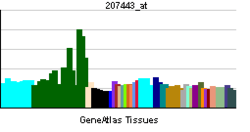TLX
| View/Edit Human | View/Edit Mouse |
Nuclear receptor TLX (homologue of the Drosophila tailless gene) also known as NR2E1 (Nuclear receptor subfamily 2 group E member 1) is a protein that in humans is encoded by the NR2E1 gene.[3] TLX is a member of the nuclear receptor family of intracellular transcription factors.
Function
TLX regulates the expression of another nuclear receptor, RAR.[4]
TLX also is essential for normal brain-eye coordination and appears to play a role in control of aggressive behavior.[5]
Adult neural stem cells are nuclear receptor TLX-positive and TLX expression in these cells is crucial in maintaining their undifferentiated state.[6] Furthermore, TLX regulates adult neural stem cell proliferation. Removal of TLX from the adult mouse brain resulted in a reduction of stem cell proliferation and spatial learning.[7]
Tlx-positive cells of the subventricular zone of adult mouse brain are self-renewing stem cells. Mutation of the Tlx gene in adult mouse brain leads to complete loss of neurogenesis in the subventricular zone. Tlx is also required for transition from radial glial cells to astrocyte-like neural stem cells.[8]
References
- ↑ "Human PubMed Reference:".
- ↑ "Mouse PubMed Reference:".
- ↑ Jackson A, Panayiotidis P, Foroni L (May 1998). "The human homologue of the Drosophila tailless gene (TLX): characterization and mapping to a region of common deletion in human lymphoid leukemia on chromosome 6q21". Genomics. 50 (1): 34–43. doi:10.1006/geno.1998.5270. PMID 9628820.
- ↑ Kobayashi M, Yu RT, Yasuda K, Umesono K (Dec 2000). "Cell-type-specific regulation of the retinoic acid receptor mediated by the orphan nuclear receptor TLX". Molecular and Cellular Biology. 20 (23): 8731–9. doi:10.1128/MCB.20.23.8731-8739.2000. PMC 86495
 . PMID 11073974.
. PMID 11073974. - ↑ Abrahams BS, Kwok MC, Trinh E, Budaghzadeh S, Hossain SM, Simpson EM (Jul 2005). "Pathological aggression in "fierce" mice corrected by human nuclear receptor 2E1". The Journal of Neuroscience. 25 (27): 6263–70. doi:10.1523/JNEUROSCI.4757-04.2005. PMID 16000615.
- ↑ Shi Y, Chichung Lie D, Taupin P, Nakashima K, Ray J, Yu RT, Gage FH, Evans RM (Jan 2004). "Expression and function of orphan nuclear receptor TLX in adult neural stem cells". Nature. 427 (6969): 78–83. doi:10.1038/nature02211. PMID 14702088.
- ↑ Zhang CL, Zou Y, He W, Gage FH, Evans RM (Feb 2008). "A role for adult TLX-positive neural stem cells in learning and behaviour". Nature. 451 (7181): 1004–7. doi:10.1038/nature06562. PMID 18235445.
- ↑ Liu HK, Belz T, Bock D, Takacs A, Wu H, Lichter P, Chai M, Schütz G (Sep 2008). "The nuclear receptor tailless is required for neurogenesis in the adult subventricular zone". Genes & Development. 22 (18): 2473–8. doi:10.1101/gad.479308. PMC 2546695
 . PMID 18794344.
. PMID 18794344.
Further reading
- Yu RT, McKeown M, Evans RM, Umesono K (Aug 1994). "Relationship between Drosophila gap gene tailless and a vertebrate nuclear receptor Tlx". Nature. 370 (6488): 375–9. doi:10.1038/370375a0. PMID 8047143.
- Kobayashi M, Yu RT, Yasuda K, Umesono K (Dec 2000). "Cell-type-specific regulation of the retinoic acid receptor mediated by the orphan nuclear receptor TLX". Molecular and Cellular Biology. 20 (23): 8731–9. doi:10.1128/MCB.20.23.8731-8739.2000. PMC 86495
 . PMID 11073974.
. PMID 11073974. - Abrahams BS, Mak GM, Berry ML, Palmquist DL, Saionz JR, Tay A, Tan YH, Brenner S, Simpson EM, Venkatesh B (Jul 2002). "Novel vertebrate genes and putative regulatory elements identified at kidney disease and NR2E1/fierce loci". Genomics. 80 (1): 45–53. doi:10.1006/geno.2002.6795. PMID 12079282.
- Abrahams BS, Kwok MC, Trinh E, Budaghzadeh S, Hossain SM, Simpson EM (Jul 2005). "Pathological aggression in "fierce" mice corrected by human nuclear receptor 2E1". The Journal of Neuroscience. 25 (27): 6263–70. doi:10.1523/JNEUROSCI.4757-04.2005. PMID 16000615.
- Kumar RA, Leach S, Bonaguro R, Chen J, Yokom DW, Abrahams BS, Seaver L, Schwartz CE, Dobyns W, Brooks-Wilson A, Simpson EM (Aug 2007). "Mutation and evolutionary analyses identify NR2E1-candidate-regulatory mutations in humans with severe cortical malformations". Genes, Brain, and Behavior. 6 (6): 503–16. doi:10.1111/j.1601-183X.2006.00277.x. PMC 2040186
 . PMID 17054721.
. PMID 17054721. - Kumar RA, Everman DB, Morgan CT, Slavotinek A, Schwartz CE, Simpson EM (2007). "Absence of mutations in NR2E1 and SNX3 in five patients with MMEP (microcephaly, microphthalmia, ectrodactyly, and prognathism) and related phenotypes". BMC Medical Genetics. 8: 48. doi:10.1186/1471-2350-8-48. PMC 1950490
 . PMID 17655765.
. PMID 17655765. - Sun G, Yu RT, Evans RM, Shi Y (Sep 2007). "Orphan nuclear receptor TLX recruits histone deacetylases to repress transcription and regulate neural stem cell proliferation". Proceedings of the National Academy of Sciences of the United States of America. 104 (39): 15282–7. doi:10.1073/pnas.0704089104. PMC 2000559
 . PMID 17873065.
. PMID 17873065.
External links
- NR2E1 protein, human at the US National Library of Medicine Medical Subject Headings (MeSH)
